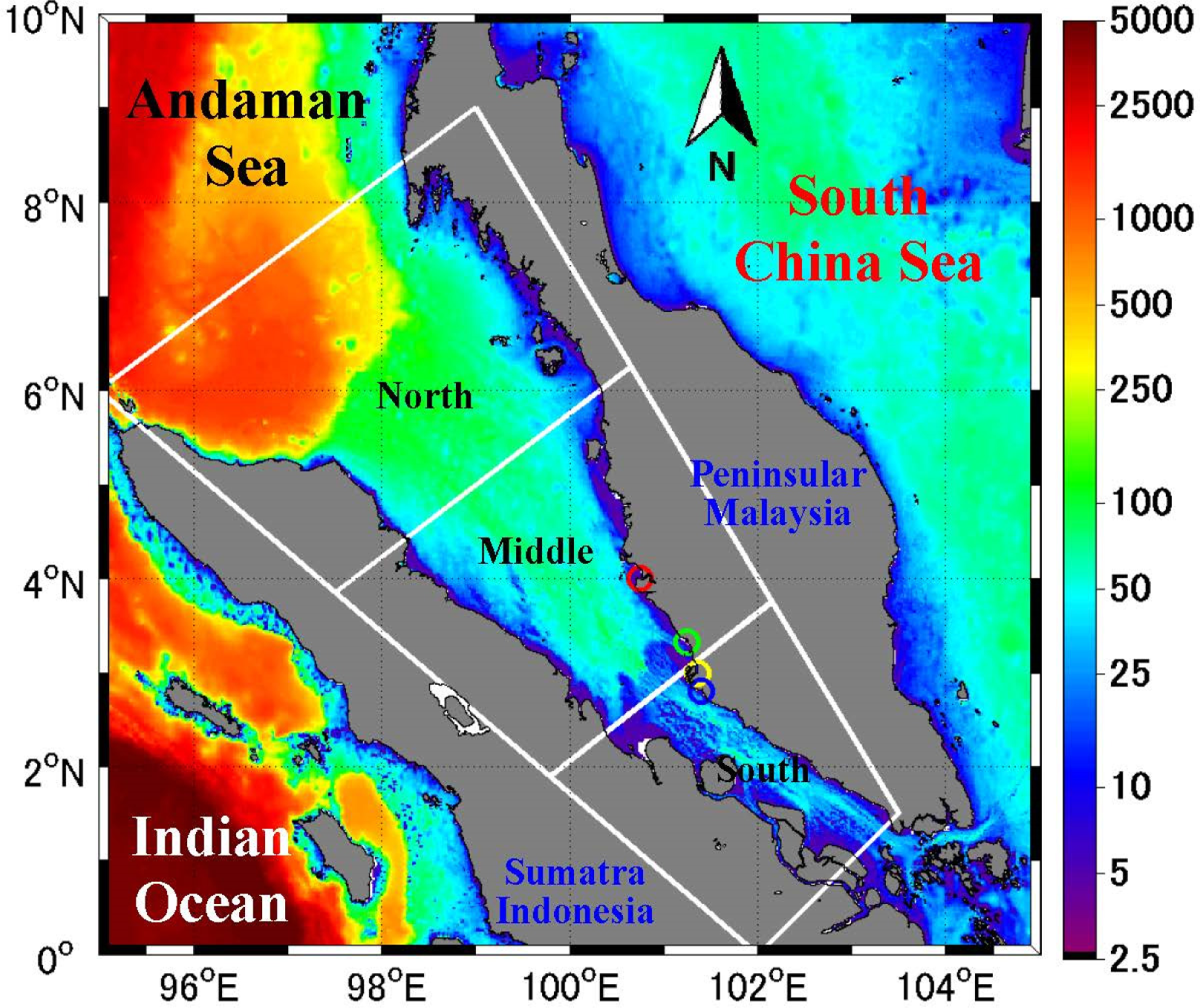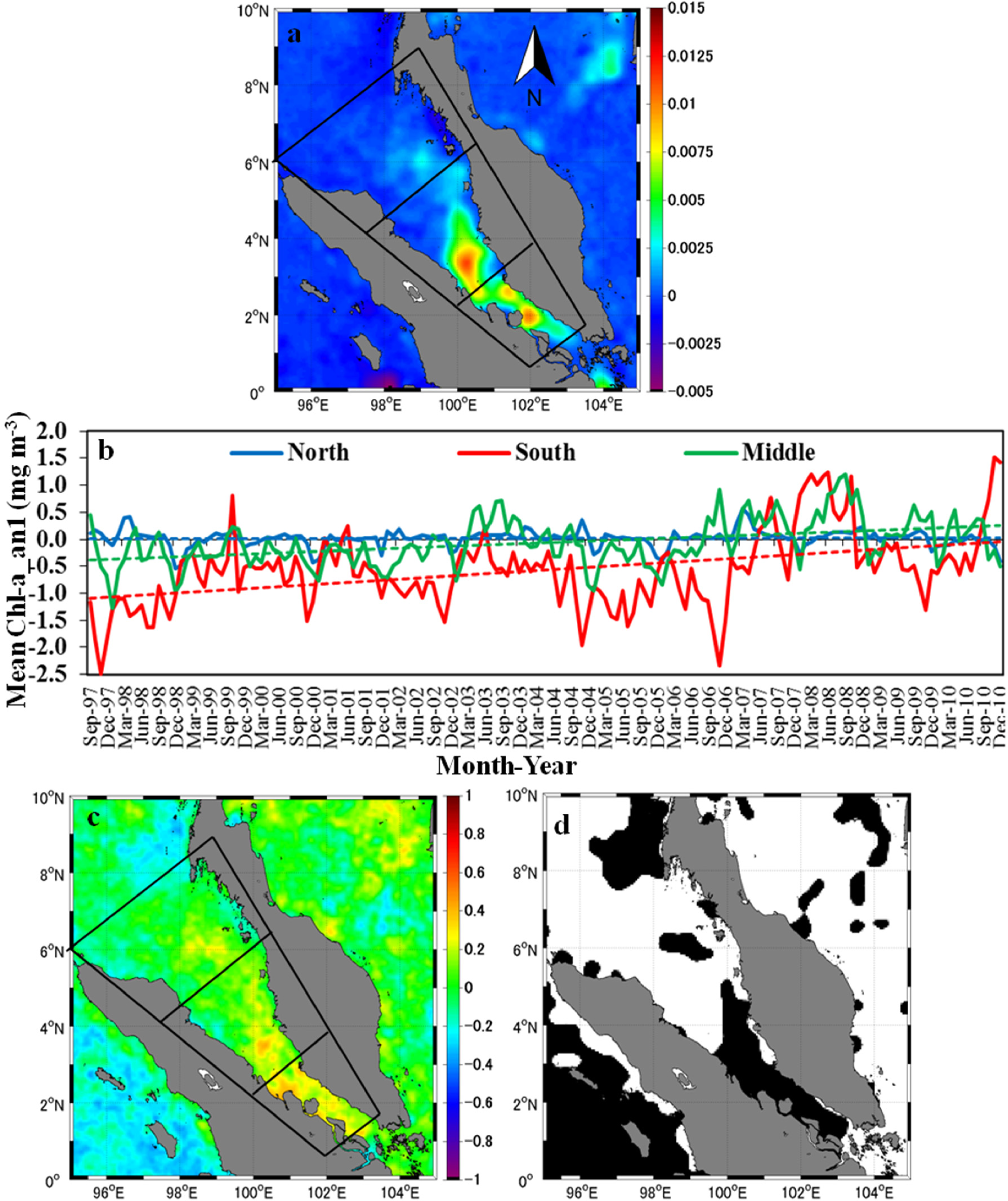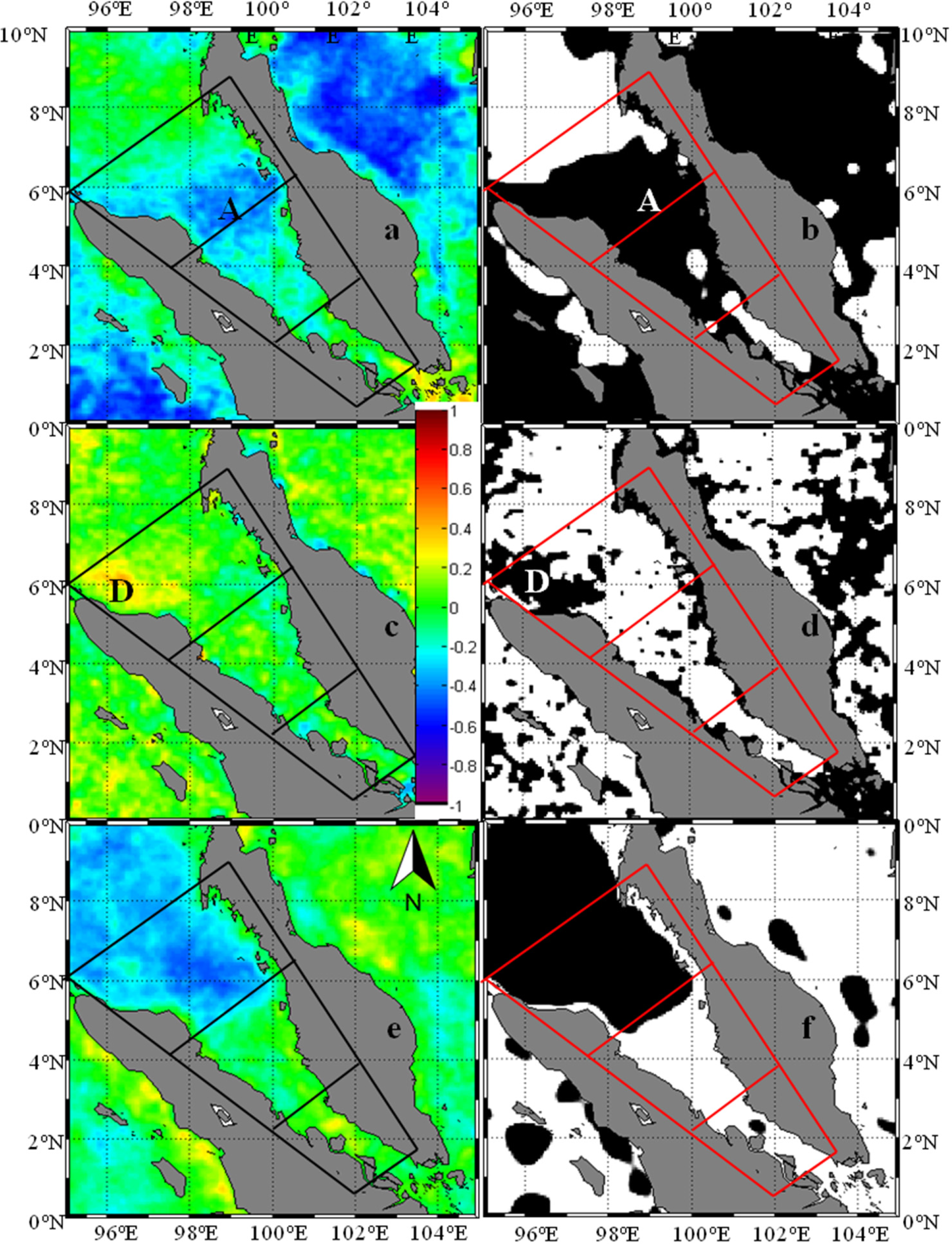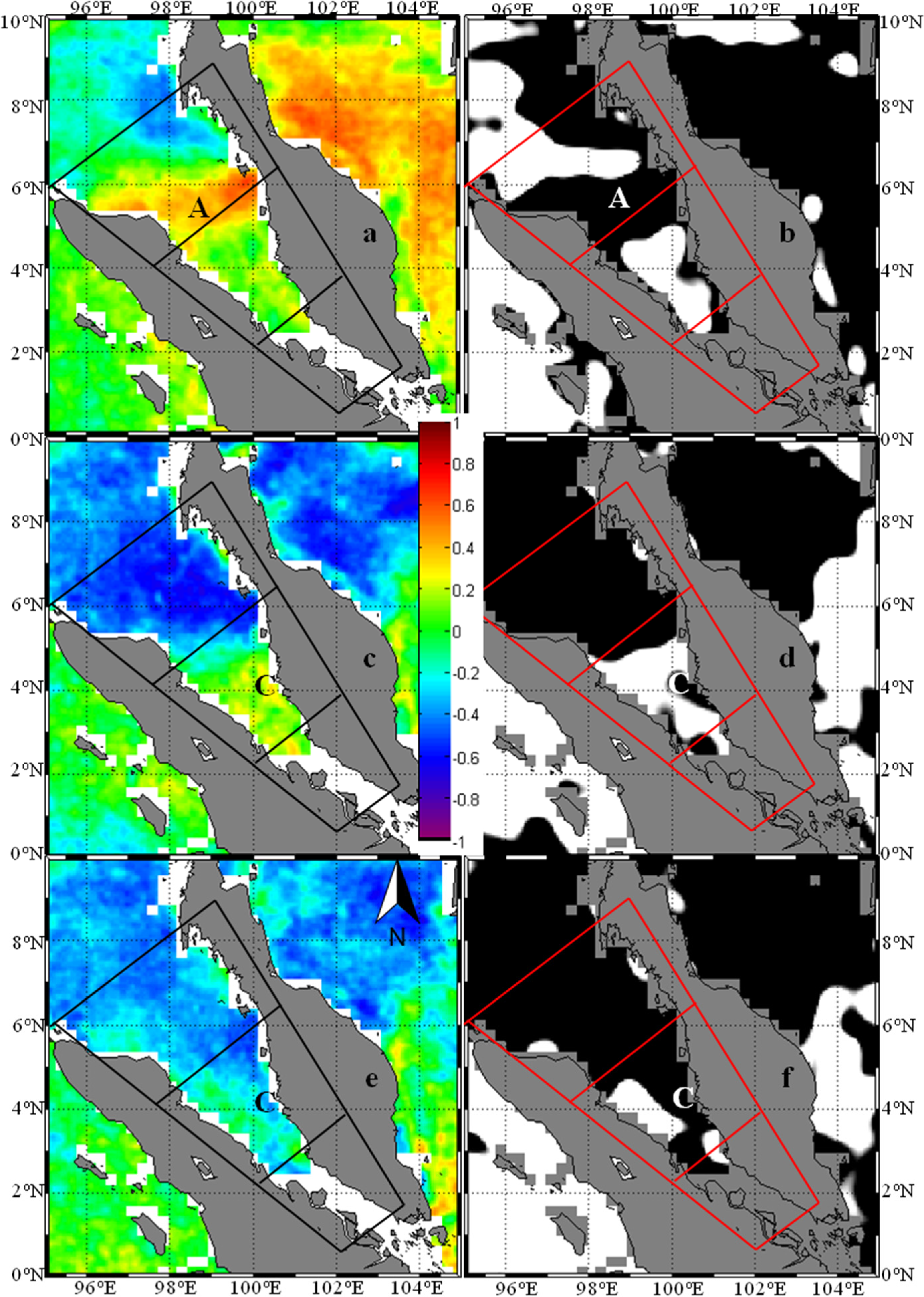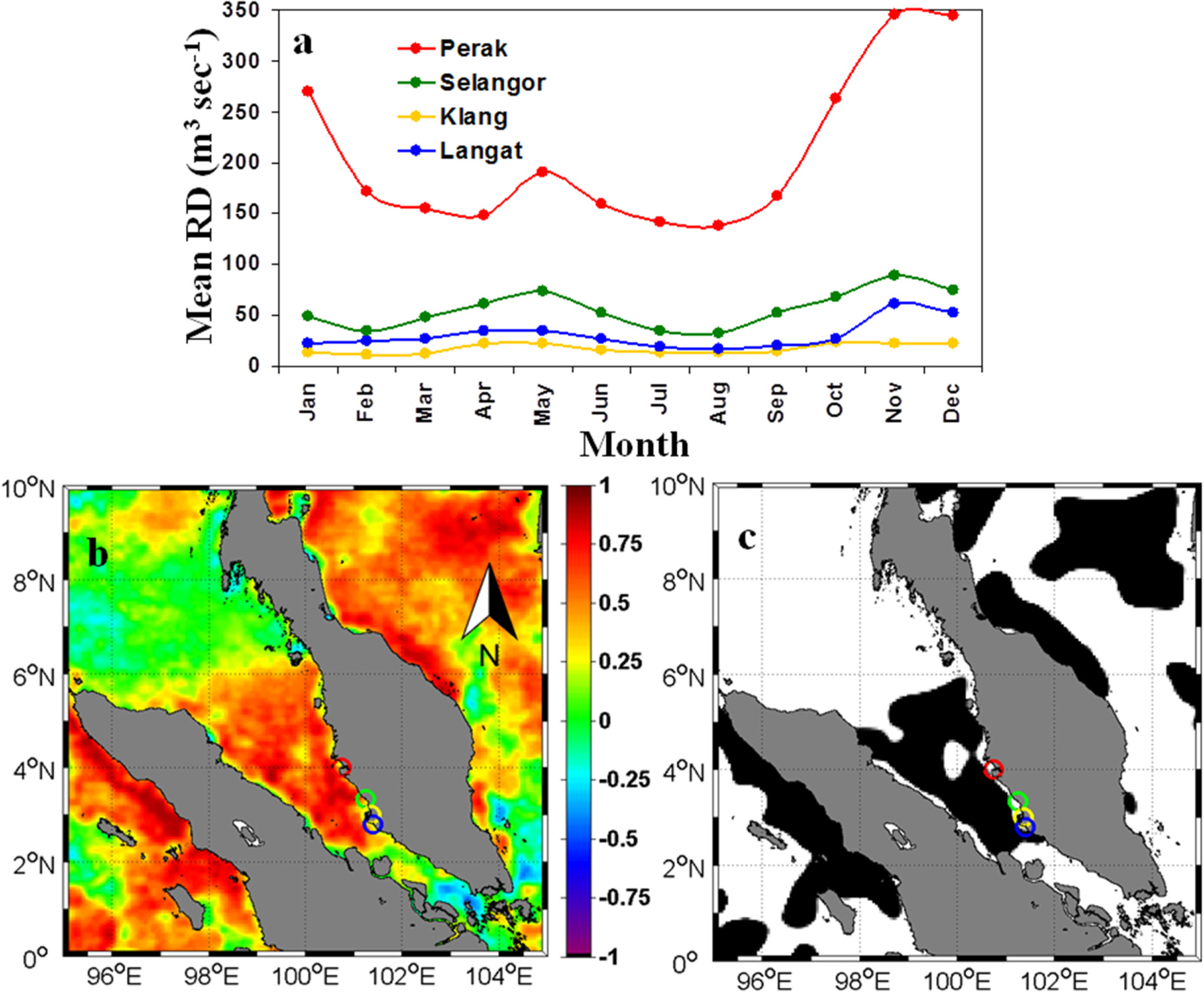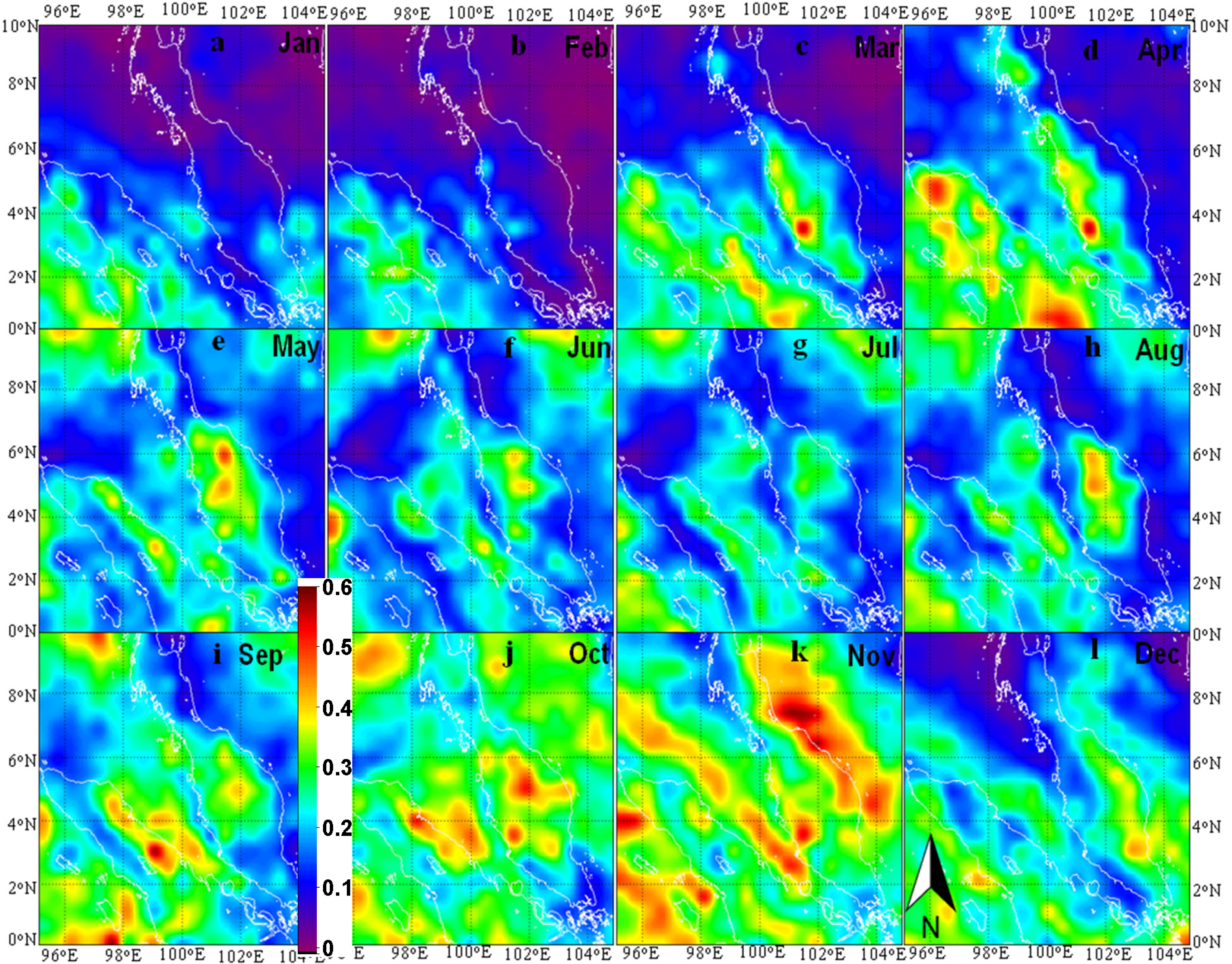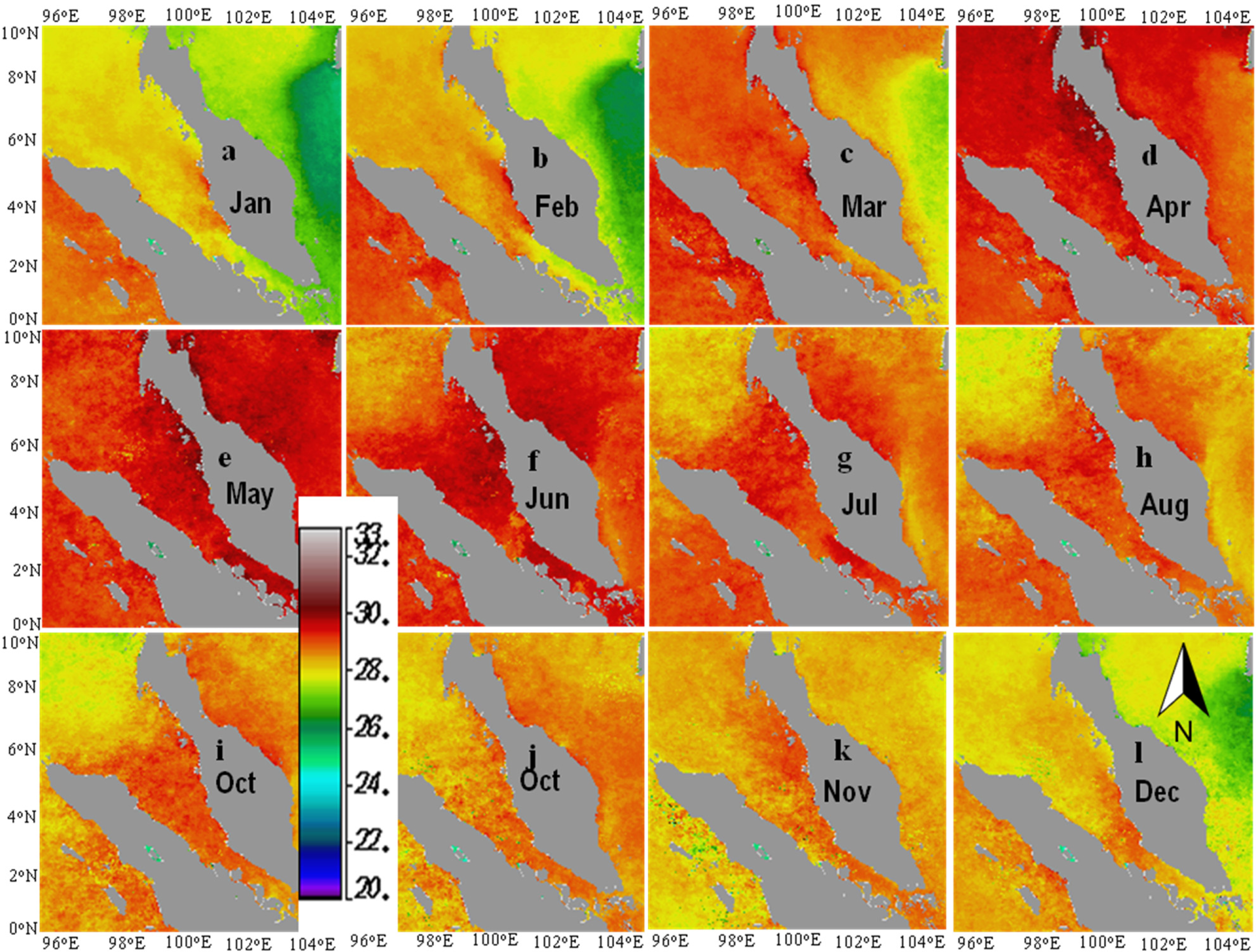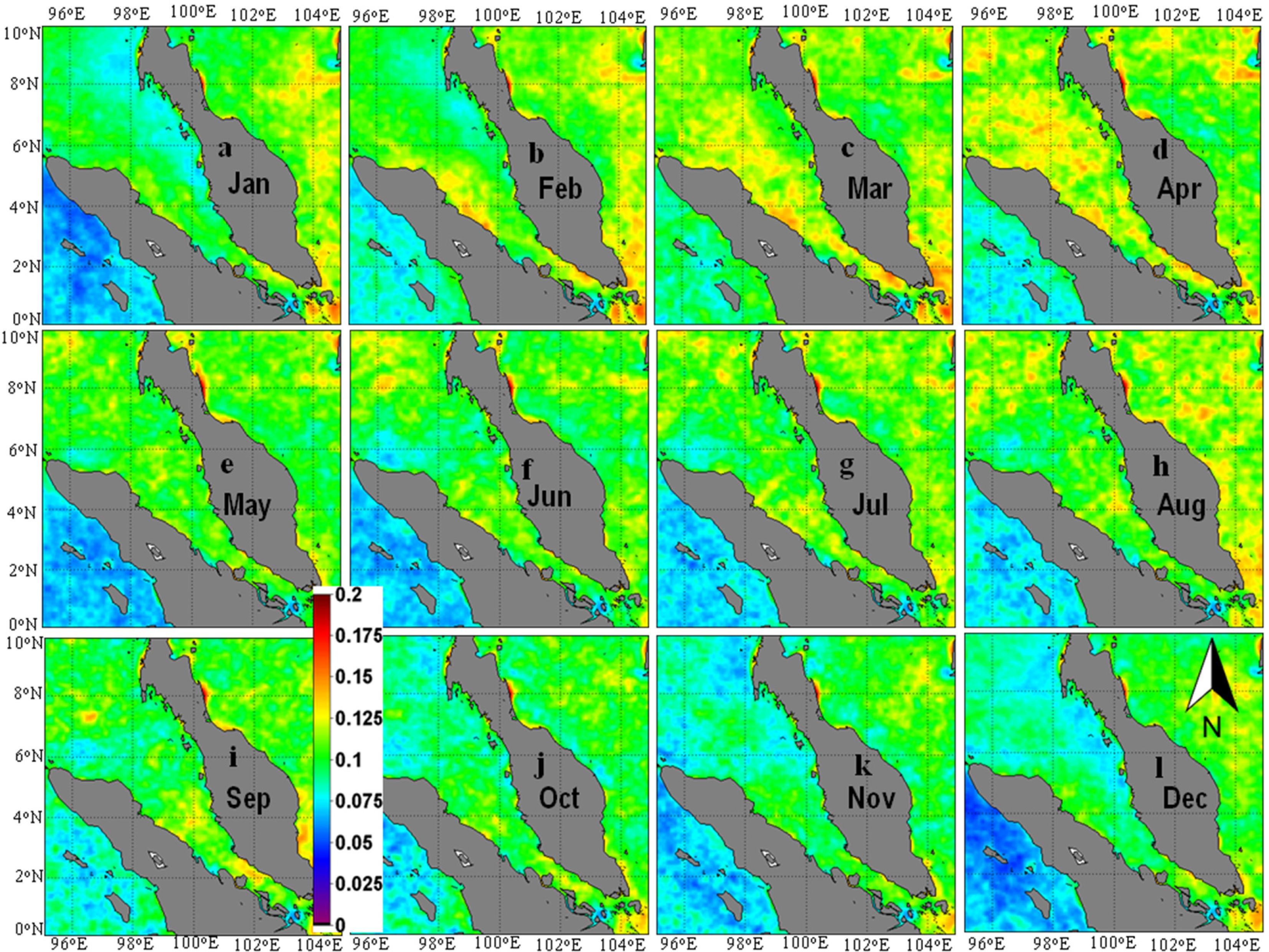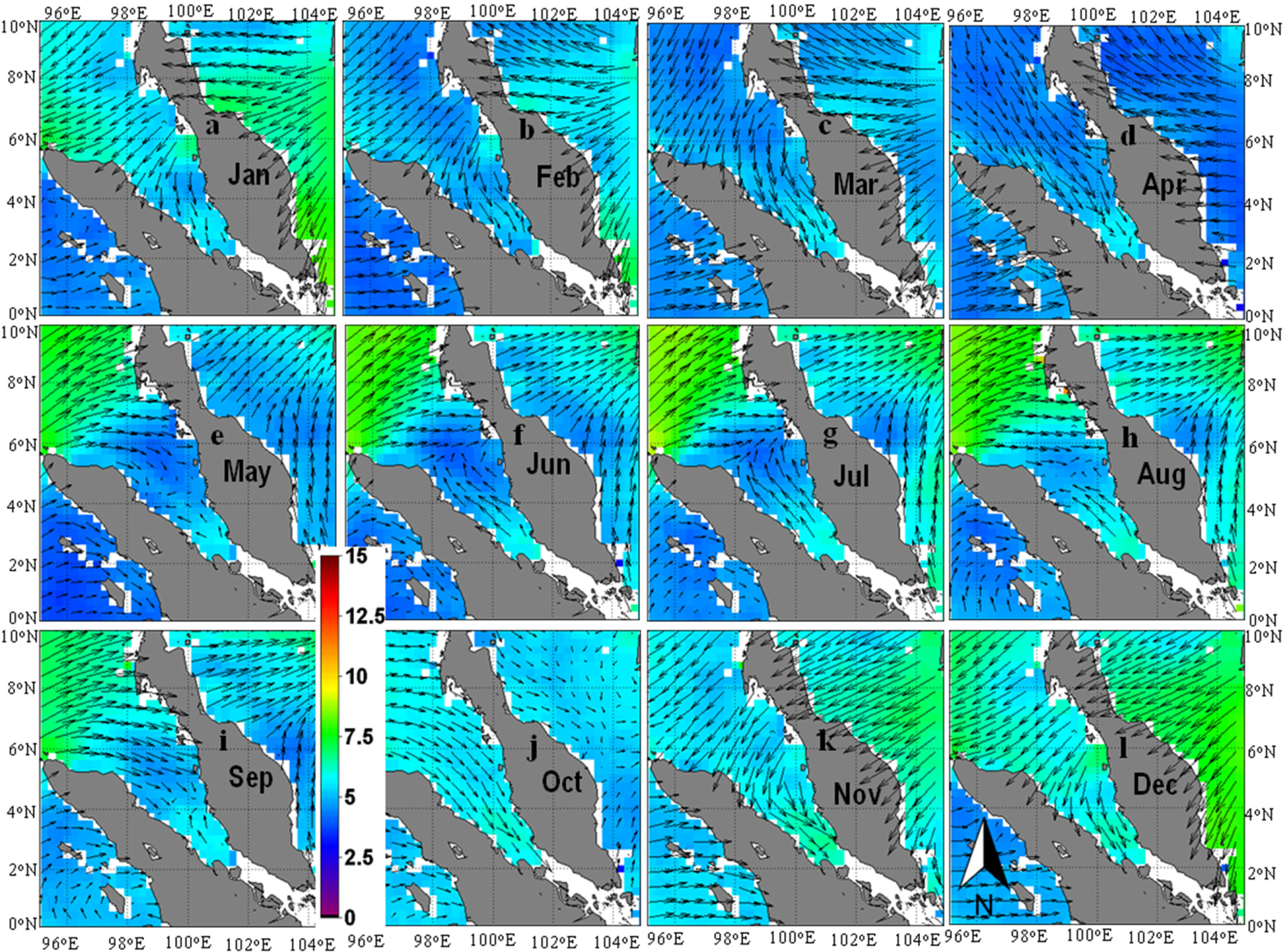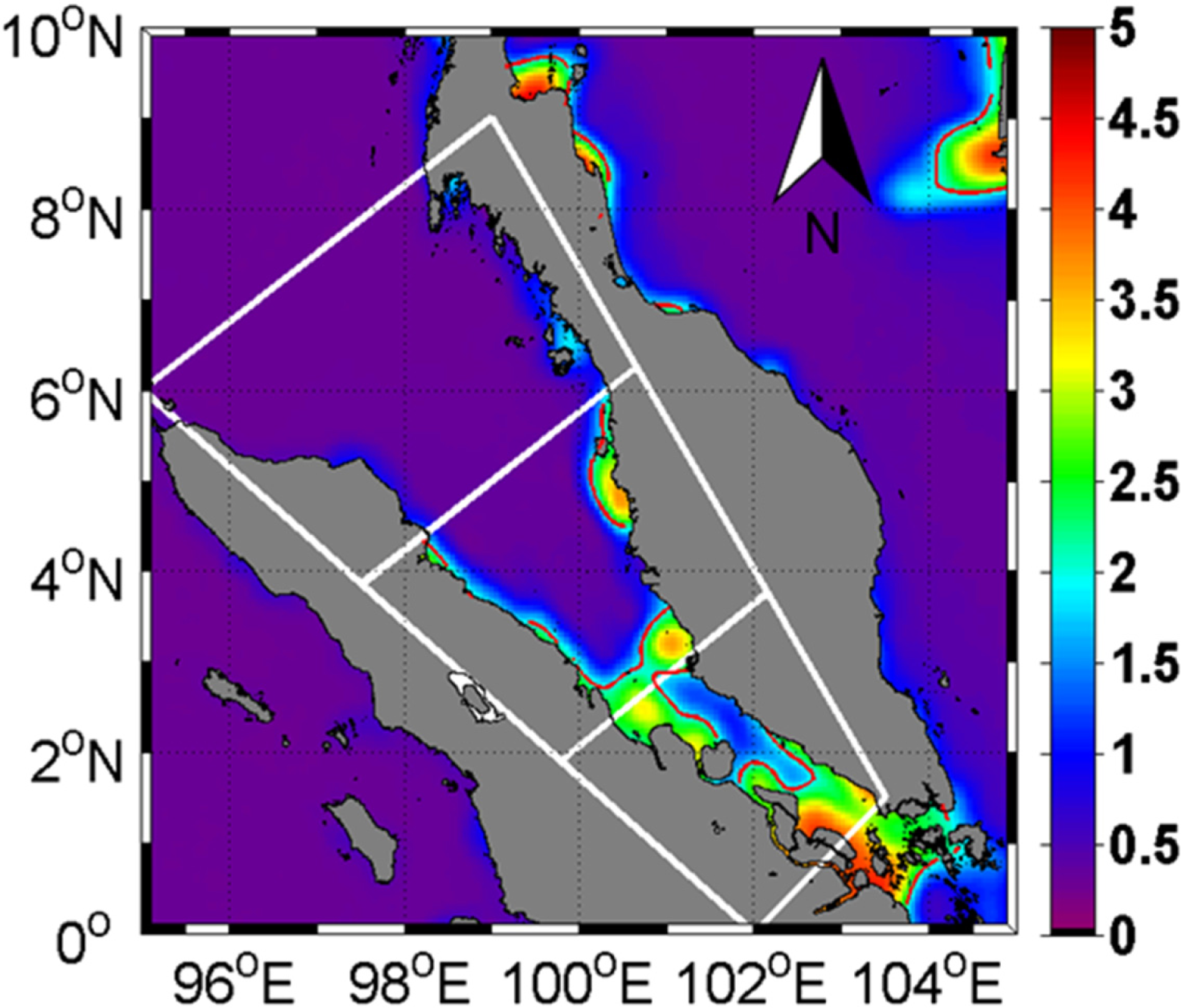3.1. Seasonal Cycles, Interannual Variations and Decadal-Scale Trends of SeaWiFS Chl-a
Over the entire region of the SM, a remarkable seasonal cycle of Chl-
a was apparent; Chl-
a was high during the NEM (
Figure 2a,b,k,l) and low during the SWM (
Figure 2e–h). A distinct seasonal variation of monthly climatological means of Chl-
a was apparent in all three regions of the SM. The time series of SeaWiFS data from 1997 to 2010 revealed a seasonal peak of Chl-
a in the southern region during October (
Figure 2m), consistent with the results of Tan
et al. [
6], which were based on a shorter time series of SeaWiFS Chl-
a data (1997–2003). The consistency between our results and those of Tan
et al. [
6] is not surprising, because our southern region was geographically almost identical to Tan
et al.’s [
6] southern region. Tan
et al.’s [
6] northern region, however, encompassed both the northern and middle regions defined in this study. Although the Chl-
a seasonal cycles were similar in our northern and middle regions, those two regions were remarkably different in terms of monthly climatological means and ranges of variation (quantified in terms of standard deviations) of Chl-
a. The peak of the Chl-
a bloom during the NEM also occurred earlier in the middle region (in December) than in the northern region (in January). Tan
et al. [
6] missed this meridional difference in the timing of the peak of the Chl-
a bloom during the NEM, because they combined both the northern and middle regions of our study into their single northern region. It is obvious from our study that the highest Chl-
a during the NEM tend to occur progressively earlier from the northern to the southern regions.
During the SeaWiFS full mission, the Chl-
a_an1 (seasonality-removed Chl-
a anomaly) tended to increase, both in the middle and southern regions. The rates of increase or slopes were about 0.004 mg·m
−3·month
−1 and 0.007 mg·m
−3·month
−1, respectively, or about 0.05 mg·m
−3·yr
−1 and 0.08 mg·m
−3·yr
−1, respectively (
Figure 3a,b). During the last decade of SeaWiFS, the rates of increase of Chl-
a in the middle and southern regions were significant, as evidenced by the significant positive correlation (
r > 0.4,
p < 0.0001) between Chl-
a_an1 and time (
Figure 3c,d). The trend of increasing Chl-
a in the middle region was likely due more to the increasing trend of Chl-
a in the southeastern part of the middle region (
Figure 3a,c,d), where the rate of change was greater than 0.005 mg·m
−3·month
−1 or 0.06 mg·m
−3·yr
−1. In the northern region of the SM, however, despite a conspicuous Chl-
a seasonal cycle, almost no trend of Chl-
a was apparent in the last decade of SeaWiFS (
Figure 3a,b), as evidenced by the absence of a significant correlation between Chl-
a_an1 and time (
Figure 3c,d).
A four-month moving average of Chl-
a_an2 (seasonality-removed and detrended Chl-
a anomaly) revealed that the largest Chl-
a interannual variations occurred in the southern region of the SM, whereas the smallest interannual variations occurred in the northern region (
Figure 4a). Chl-
a interannual variations in the southern region were particularly apparent during the period from September 1997, to May 1998, and from July 2004 to March 2007, when Chl-
a tended to be low. The periods from January 1999 to September 2001, from September 2007 to November 2008, and during September 2010, however, were characterized by high Chl-
a.
Interannual variations of Chl-
a in the southern region were inversely associated with Nino3.4 (
Figure 4a), as is also evidenced by the significant negative correlation between Chl-
a_an2 and Nino3.4 (
r = −0.52,
p < 0.01) (
Table 1). This relationship implies that Chl-
a in the southern region of the SM tended to be low during El Niño (positive Nino3.4) and high during La Niña (negative Nino3.4) years. In contrast, in the northern region, there was a statistically significant positive correlation (
r = 0.26,
p < 0.01) between Nino3.4 and Chl-
a_an2. There was also a significant positive correlation (
r = 0.18,
p < 0.05) between Chl-
a_an2 and DMI in the northern region, but this correlation was weaker than the positive correlation between Chl-
a_an2 and Nino3.4. In the middle region, however, there was no apparent association between Chl-
a_an2 and Nino3.4 (
Figure 4a,
Table 1), but there was a significant positive correlation (
r = 0.31,
p < 0.01) between Chl-
a_an2 and DMI.
3.2. Correlations between SeaWiFS Chl-a and Other Satellite-Retrieved Environmental Variables
On a seasonal timeframe, we used non-parametric correlation (with no time lag) to investigate pixel-based relationships between Chl-
a and other satellite-derived environmental variables, the goal being to discern the factors that were likely responsible for the seasonal and spatial variations of Chl-
a in the SM. A statistically significant negative correlation (
r < −0.4,
p < 0.05) between Chl-
a and SST was apparent over a wide area within the northern and middle regions of the SM (Area A in
Figure 5a,b). There was almost no significant relationship between Chl-
a and AOT, except for an area in the northwestern part of the SM northern region (Area D in
Figure 5c,d), where there was a significant positive correlation (
r > 0.3,
p < 0.05) between Chl-
a and AOT. There was a very significant negative correlation (
r < −0.4,
p < 0.05) between RR and Chl-
a in the northern region of the SM (
Figure 5e,f). This significant negative correlation extended to the Andaman Sea, whereas in the SM middle and southern regions, there was almost no association between Chl-
a and RR.
An east-west, belt-like pattern of significant positive correlation (
r > 0.5,
p < 0.05) between Chl-
a and WS was apparent approximately in Area A (
Figure 6a,b). There was no significant correlation between Chl-
a and WS within a large portion of the middle region of the SM and northern part of the northern region of the SM. There was a significant negative correlation (
r < −0.5,
p < 0.05) between U and Chl-
a in the northern region of the SM (
Figure 6c,d). However, a significant positive correlation coefficient (
r > 0.3,
p < 0.05) was apparent in some pixels near the coastal regions (Area C). Like U, V also showed a significant negative correlation with Chl-
a (
r < −0.3,
p < 0.05) in the northern region of the SM (
Figure 6e,f). In the Peninsular Malaysian coastal area of the middle region of the SM (Area C), a significant negative correlation was also observed, but no significant correlation was apparent on the opposite side (the coastal area of Sumatra).
The monthly climatological mean of RD was highest in November, especially in the cases of the Perak, Selangor and Langat Rivers (
Figure 7a). The average RR over Peninsular Malaysia was also highest during November (
Figure 8k). The fact that the period of second highest RD was April–May is also consistent with the relatively high RR along the western side of Peninsular Malaysia (
Figure 8d,e). High RR during the NEM inevitably increases freshwater discharge into the SM, as evidenced by the minimum of surface salinity during the NEM [
24]. Besides transporting freshwater, RD also transports nutrients from the land into the SM. A significant positive correlation (
r > 0.5,
p < 0.05) between monthly climatological Chl-
a and monthly climatological RD (average for the four main rivers,
Figure 7b,c) in approximately the same area of RD-diluted, low-salinity water [
24] may reflect the role of the seasonality of RR in determining seasonal Chl-
a variations in the SM through the influx of nutrients from the land.
To identify the probable drivers of interannual variations of Chl-
a associated with large-scale climatic anomalies, we computed the correlation between SeaWiFS Chl-
a_an2 and other variable anomalies (seasonality-removed and detrended anomalies). Interannual Chl-
a variations in the northern region of the SM were significantly correlated with the AOT anomaly (AOT_an2) (
r = 0.25,
p < 0.05,
Table 1), the indication being that AOT was the main driver responsible for the interannual variations of Chl-
a associated with both ENSO and IOD events. U seemed to be the second-most important driver of interannual variations of Chl-
a, as evidenced by the significant negative correlation (
r = −0.21,
p < 0.05) between the U anomaly (U_an2) and Chl-
a_an2. In the middle region of the SM, RR seemed to be the primary factor responsible for interannual variations of Chl-
a associated with the IOD, as evidenced by the significant positive correlation (
r = 0.20,
p < 0.05) between SeaWiFS Chl-
a_an2 and the RR anomaly (RR_an2). The second most important variable was AOT, as evidenced by the significant positive correlation (
r = 0.19,
p < 0.05) between SeaWiFS Chl-
a_an2 and AOT_an2. In the southern region of the SM, RR seemed to be the most important driver of Chl-
a interannual variations associated with ENSO events, as evidenced by the significant correlation (
r = 0.17,
p < 0.05) between SeaWiFS Chl-
a_an2 and RR_an2.
3.3. Factors Responsible for the SeaWiFS Chl-a Seasonal Cycle
The seasonal cycle of Chl-
a was apparent both in the northern and middle regions of the SM (
Figure 2m), where Chl-
a showed a significant negative correlation with SST (
Figure 5a,b), a reflection of the seasonal association between high (low) Chl-
a and low (high) SST during the NEM (SWM) (
Figures 2 and
9). The negative correlation between SST and Chl-
a implies that SST was not a factor that drove the Chl-
a seasonal cycle. The negative correlation between Chl-
a and SST contradicts the basic tenet of temperature-dependent phytoplankton growth [
25]. The negative correlation between Chl-
a and SST, however, may be indicative of nutrient-limited phytoplankton growth [
26], especially considering that SST is consistently higher than 20 °C throughout the year (
Figure 9).
The seasonal cycles of Chl-
a in the northern and middle regions of the SM must, therefore, be associated with seasonal cycles of nutrient fluxes. Nutrients can be supplied by vertical fluxes (by dry or wet atmospheric deposition and by deep water upwelling/mixing) and from horizontal nutrient fluxes (loading by RD) [
27–
29]. Considering the weak correlation between Chl-
a and AOT (
Figure 5c,d) and the negative correlation between Chl-
a and RR (
Figure 5e,f), a role of atmospheric dry and wet deposition as nutrient sources in controlling the seasonal Chl-
a cycle can be ruled out. The positive correlation between Chl-
a and AOT in Area D (
Figure 5c,d), where both Chl-
a and AOT are low during the SWM (
Figure 2f,g,h and
Figure 10f,g,h), probably does not reflect direct causation. In other words, a decrease of the AOT during the SWM does not decrease Chl-
a, but seasonal winds drive seasonal cycles of Chl-
a. Hence, there are two possible sources of nutrients that may drive the seasonal cycle of Chl-
a, namely, vertical fluxes from deep layers and/or horizontal fluxes from RD.
The significant negative correlations between U and Chl-
a and between V and Chl-
a in the northern region of the SM (
Figure 6c–f) reflect the seasonal coupling between high Chl-
a and the strong northeasterly winds that occur during the NEM (
Figure 11a,b,k,l) and between low Chl-
a and the weak southwesterly winds that occur during the SWM (
Figure 11e–h). Strong northeasterly winds during the NEM may increase the Chl-
a in the northern region of the SM (
Figure 2a,b,k,l) in two ways: (1) by increasing the flux of nutrients to surface waters through water column vertical entrainment; and (2) by northwestward horizontal advection of high-Chl-
a water from the middle region of the SM via wind-driven Ekman transport [
6]. This northwestward Ekman transport probably accounts for the fact that the Chl-
a bloom occurs earlier in the middle region (December) compared to in the northern region (January) (
Figure 2m). The low Chl-
a in the northern region of the SM during the period of weak southwesterly winds may reflect the small amount of water column upward entrainment of nutrients, as well as the southeastward advection of low-Chl-
a water from the Andaman Sea via Ekman transport [
7].
The high Chl-
a during the NEM in the middle region of the SM was caused mainly by the increase of Chl-
a along the coast of Peninsular Malaysia. One of the possible mechanisms underlying this coastal Chl-
a increase is wind-driven coastal upwelling, the evidence for which is the significant negative correlation between V and Chl-
a in the coastal area of Peninsular Malaysia (Area C,
Figure 6e,f). This coastal upwelling is possible during the NEM, because the middle region of the SM is in the northern hemisphere (∼4°N), and the prevailing winds are alongshore and northwesterly. The positive wind stress curls of >0.04 × 10
−5 Pa·m−1 in Area C (
Figure 12a,b,k,l) are also consistent with the occurrence of coastal upwelling during the NEM.
Besides coastal upwelling, high RD in November from Peninsular Malaysia may also have been an important source of allochthonous nutrients from the land. The significant positive correlation between monthly climatological means of RD and Chl-
a in the coastal area adjacent to the river estuaries is consistent with this hypothesis (
Figure 7b,c). Identifying which factor (upwelling or RD) is more important in causing the Chl-
a to be high during the NEM in the middle region of the SM was beyond the scope of this study, because the temporal resolutions of the RD and satellite data were not the same.
The less pronounced seasonal cycle of Chl-
a in the southern region of the SM was, to some extent, likely caused by overestimation of SeaWiFS Chl-
a. A previous study [
6] has mentioned that SeaWiFS Chl-
a in turbid coastal areas of the southern region of the SM were an average of about 130% and 480% of the
in situ Chl-
a during the NEM and SWM, respectively. During the SeaWiFS full mission, the normalized water-leaving radiance at 555 nm (nLw555) was >1 mW·cm
−2·μm
−1·sr
−1 (see
Figure 13) over half of the southern region of the SM, the implication being that the water in half of the southern region of the SM was turbid. We therefore estimate the Chl-
a associated with phytoplankton to be about 3.0 mg·m
−3 and 1.4 mg·m
−3 during the NEM and SWM, respectively. These roughly corrected Chl-
a in the southern region of the SM made the seasonal cycle and magnitude of Chl-
a in the southern region of the SM closely resemble the Chl-
a in the middle region of the SM, that is high Chl-
a during the NEM, but low during the SWM. The high (low) RR during the NEM (SWM), both from Sumatra and Peninsular Malaysia, was probably one of the factors responsible for causing high (low) Chl-
a in the southern region of the SM via the allochthonous flux of nutrients from RD.
3.4. Factors Responsible for the Trends and Interannual Variations of SeaWiFS Chl-a
Significant trends (rate > 0.04 mg·m
−3·month
−1,
p < 0.05,
Figure 3) of increasing SeaWiFS Chl-
a during the SeaWiFS full mission were apparent in the middle and southern regions of the SM. As discussed above, however, SeaWiFS Chl-
a in the southern region of the SM very much overestimates
in situ Chl-
a [
6], especially in turbid regions where the nLw555 was >1 mW·cm
−2·μm
−1·sr
−1. Because Tan
et al. [
6] reported
in situ Chl-
a only during the NEM and SWM, we were unable to estimate the degree of SeaWiFS overestimation of Chl-
a in other months during the monsoon transitional seasons. We were therefore unable to estimate the trend of real Chl-
a. The trend during the last decade of SeaWiFS Chl-
a in the southern region of the SM may also reflect trends of other variables (e.g., inorganic suspended sediment, gelbstoff), which are likely to cause incorrect Chl-
a retrieval by the NASA standard ocean color algorithm. The trend of real phytoplankton abundance in the southern region of the SM will therefore remain unclear until the problem of SeaWiFS Chl-
a overestimation can be resolved.
As described above, the trend of increasing SeaWiFS Chl-
a in the southern region may be due to increasing trends of other variables that lead to increasing Chl-
a retrieved by the NASA ocean color algorithm. The spatial average of Chl-
a_an1 in the southern region of the SM significantly increased during the period of this study, as evidenced by the significant correlation (
r = 0.43,
p < 0.0001,
Figure 3b or
Figure 14) between SeaWiFS Chl-
a_an1 and time. However, environmental variable anomalies of SST_an1, AOT_an1, RR_an1 and WS_an1 showed no significant trends (all
r are ≤0.1,
p > 0.1,
Figure 14). There were no RD data available during the study period, but considering the fact that there was no trend of RR, the possibility that there was a change of RD during the decade associated with the SeaWiFS Chl-
a trend can be ruled out. Therefore, other uninvestigated variables, the trends of which were independent of the trends of the investigated environmental variables, may have been responsible for the trend of increasing SeaWiFS Chl-
a in the southern region of the SM.
Among undefined variables responsible for the observed trend of increasing SeaWiFS Chl-
a in the southern region are increasing nutrient concentrations due to fertilizer use [
30] and/or mangrove degradation/land deforestation [
31], which may lead to increases of both phytoplankton and inorganic suspended matter. Further research, including studies of changes in land use, land-cover and socio-agricultural issues, is definitely needed to understand land-sea interactions, which may be responsible for changes in the marine environment (including SeaWiFS Chl-
a) of the southern region of the SM.
Unlike the southern region, most of the middle region of the SM was characterized by low turbidity, as indicated by the nLw555 of <1 mW·cm
−2·μm
−1·sr
−1. Therefore, a significant trend of increasing SeaWiFS Chl-
a can be considered to be largely due to a trend of increasing phytoplankton abundance. However, none of the investigated variables in the middle region showed remarkable trends (data not shown). Therefore, like the southern region of the SM, the trend of increasing SeaWiFS Chl-
a in the middle region of the SM was probably associated more with variables whose trends were independent of the investigated variables, such as increasing surface nutrient concentrations due to increased use of fertilizer [
30].
In regard to interannual variations, the northern region of the SM seemed to be more responsive to ENSO (
r = 0.26,
p < 0.01) than to IOD (
r = 0.18,
p < 0.05,
Table 1). The correlations between positive climate changes and Chl-
a increases were nevertheless both statistically significant, the implication being that during both El Niño (positive Nino3.4) and positive IOD events, Chl-
a in the northern region tended to increase significantly. Among the investigated environmental variables, AOT is likely the principal factor responsible for interannual variations of Chl-
a in the northern region, as evidenced by the significant positive correlation between Chl-
a_an2 and AOT_an2 (
r = 0.25,
p < 0.05). It is well known that both El Niño and positive IOD events cause severe droughts in Indonesia, and those droughts are frequently followed by wildfires [
11,
12]. Dry atmospheric deposition of macro- and/or micro-nutrients from aerosols as a result of wildfires probably fertilized the northern region of the SM. This fertilization is a likely explanation for the significant correlation between AOT and Chl-
a in the northern region [
12]. RR arises as one of the most important variables in causing interannual variations of Chl-
a in the northern region (
r = 0.18,
p < 0.05 for Chl-
a_an2
versus RR_an2). Seemingly, the mechanism by which RR increases Chl-
a in the northern region during both El Niño and positive IOD conditions is related to the intensification of wet atmospheric deposition, due to high concentrations of atmospheric aerosols during both El Niño and positive IOD conditions.
In the middle region of the SM, Chl-
a interannual variations were more responsive to the IOD than to ENSO events. A significant positive correlation (
r = 0.31,
p < 0.01) between the DMI and SeaWiFS Chl-
a_an2 in the middle region implies that during positive IOD conditions (positive DMI), Chl-
a in the middle region tended to increase. Among the explanatory variables, AOT_an2 and RR_an2 appear to be the main causes of interannual variations of Chl-
a in the middle region, as evidenced by significant correlations between AOT_an2, RR_an2 and Chl-
a_an2 (
r >= 0.19,
p < 0.05) and, to some degree, by their co-variations (
Figure 4a–c, green lines). The same mechanism operative in the northern region also applies in the middle region. Droughts occur during positive IOD events, and both dry and wet atmospheric deposition of aerosols from wildfires likely elevate surface nutrient concentrations.
The climatic anomaly of ENSO seemed to be more important in causing interannual variations of Chl-
a in the southern region of the SM (
Figure 4a), as evidenced by the significant negative correlation between Nino3.4 and SeaWiFS Chl-
a_an2 (
r = −0.52,
p < 0.01). However, note that this interannual variation of Chl-
a may not be associated only with interannual variations of phytoplankton abundance; it may also reflect the problematic SeaWiFS Chl-
a retrieval, as described above. Among the obvious interannual variations of SeaWiFS Chl-
a in the southern region were the low Chl-
a in 1997 and during the period from 2004 to 2006 (see both
Figures 3b and
4a, red lines). Those two periods were times of severe drought in Peninsular Malaysia associated with El Niño events. In fact, RR during those periods was anomalously low (
Figure 4b, red line). The significant positive correlation (
r = 0.17,
p < 0.05) between SeaWiFS Chl-
a_an2 and RR_an2 is also noteworthy. This correlation implies that droughts during El Niño events are likely to reduce RR and, hence, RD, and their reduction further reduces nutrient and sediment loads from the land. This effect will ultimately reduce total suspended matter, both in the form of phytoplankton and inorganic suspended matter, the result being low SeaWiFS Chl-
a retrieval in the southern region of the SM during El Niño years. The impacts of large-scale climatic anomalies on seemingly real phytoplankton abundance in the southern region of the SM were hence unresolved in this study, for the reasons described above.
Development of a local Chl-
a algorithm, especially a semi-analytical algorithm that allows separate retrievals of not only Chl-
a, but also of other in-water constituents, will be necessary for the quantification of the spatial and temporal variations of real Chl-
a, not only in the southern region of the SM, but also in optically complex turbid coastal waters [
32]. In addition, instead of satellite-derived Chl-
a, satellite-derived fluorescence line height (FLH, but since 1999 (2002) for MODIS-Terra (Aqua)) may be a better variable to use for tracing the seasonal cycles, interannual variations and long-term trends of real phytoplankton abundance, because satellite-retrieved FLH represents real phytoplankton better than satellite-retrieved Chl-
a in waters optically influenced by inorganic suspended matter and gelbstoff [
33].
